Abstract
A series of human bronchial-carcinoma xenografts (3 small-cell anaplastic, 2 large-cell anaplastic and 3 adenocarcinomas) established in immune-suppressed mice were treated with combination chemotherapy based on clinical regimes. Xenograft response was assessed by the in situ endpoint of growth delay in s.c. tumours. Dose-response relationships of 3 triple-drug combinations and their component agents were explored, allowing the relative contributions of single agents in each combination to be assessed. The results demonstrate that the effects produced in the xenografts were generally consistent with clinical experience. Procarbazine, cyclophosphamide and CCNU stood out as the most effective drugs in small cell carcinoma, but were ineffective in the other histological types. These was some evidence for individuality of therapeutic response among the grafts, supporting the case for incorporating panels of histologically similar xenografts into primary drug-screening programmes to complement existing syngeneic rodent tumour systems.
Full text
PDF

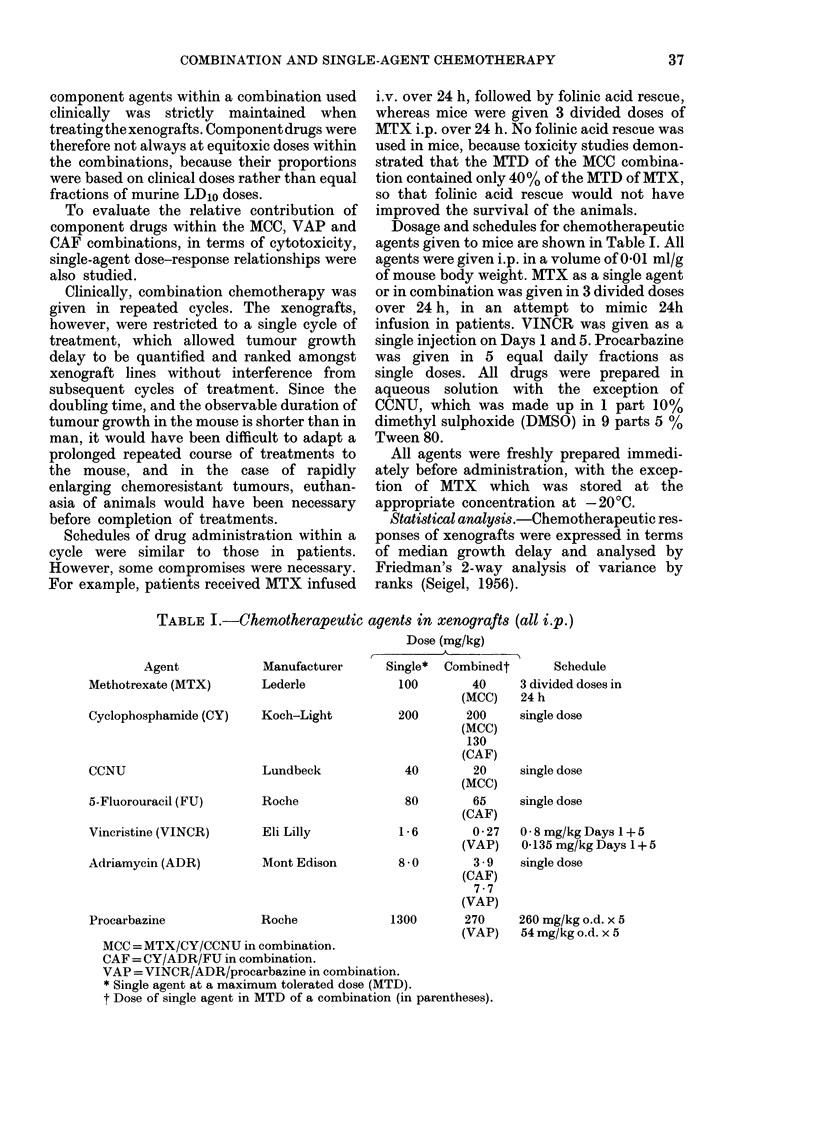

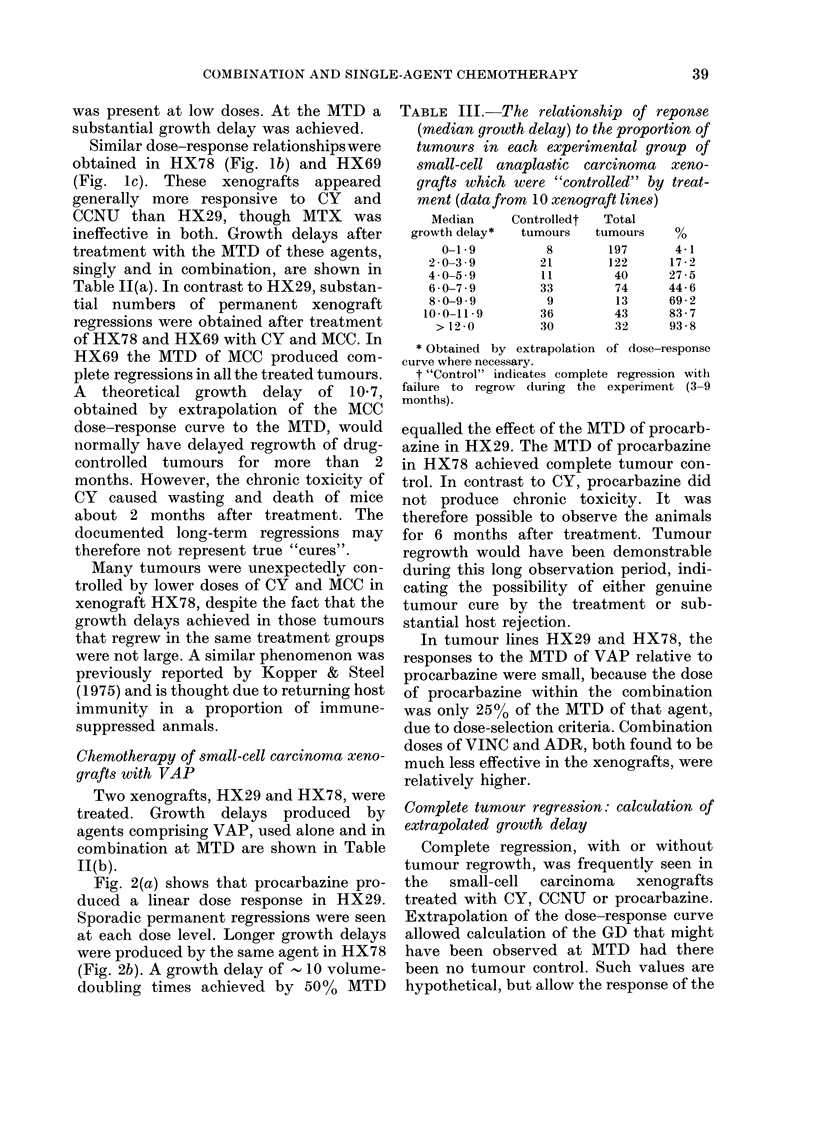

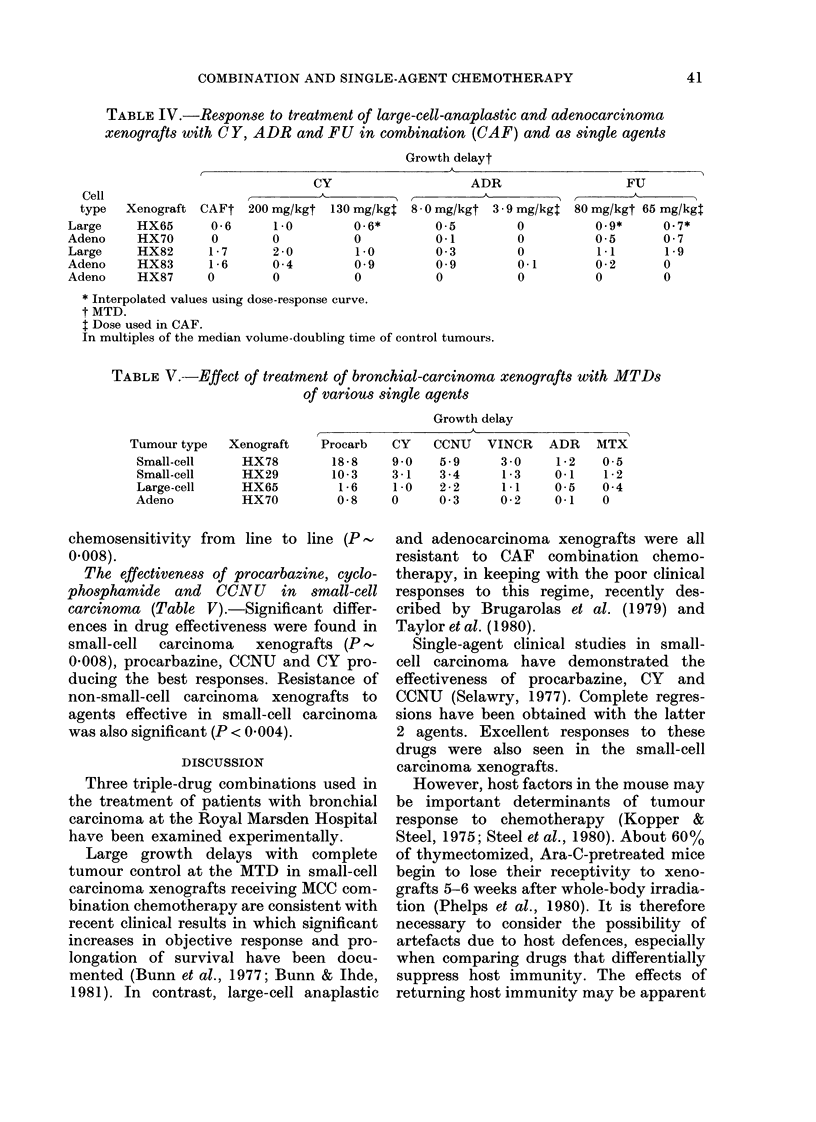
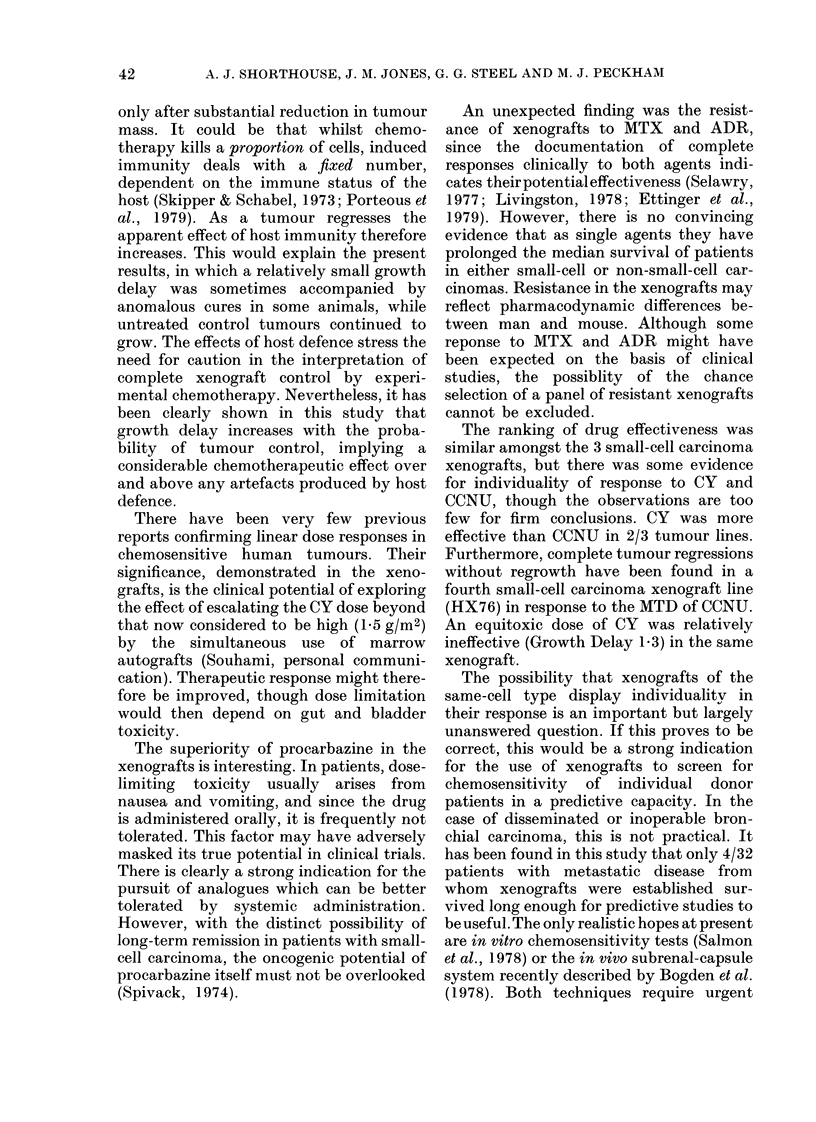

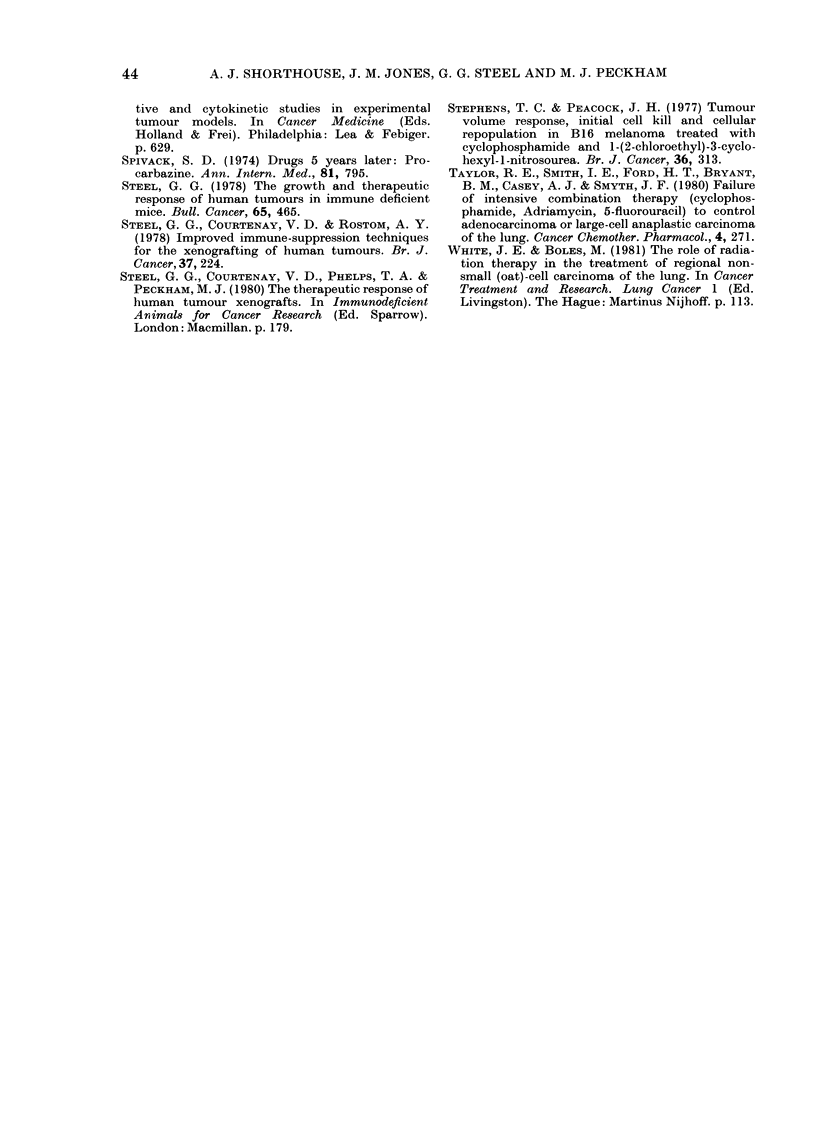
Selected References
These references are in PubMed. This may not be the complete list of references from this article.
- Bruce W. R., Meeker B. E., Powers W. E., Valeriote F. A. Comparison of the dose- and timesurvival curves for normal hematopoietic and lymphoma colony-forming cells exposed to vinblastine, vincristine, arabinosylcytosine, and amethopterin. J Natl Cancer Inst. 1969 Jun;42(6):1015–1025. [PubMed] [Google Scholar]
- Brugarolas A., Lacave A. J., Ribas A., Buesa J. M., Garcia Miralles M. T. Results of two sequential chemotherapy studies in WHO Types I, III and IV lung cancer: cyclophosphamide-5-fluorouracil (CF) and cyclophosphamide-5-fluorouracil-adriamycin (CAF). Eur J Cancer. 1979 Mar;15(3):331–335. doi: 10.1016/0014-2964(79)90044-6. [DOI] [PubMed] [Google Scholar]
- Bunn P. A., Jr, Cohen M. H., Ihde D. C., Fossieck B. E., Jr, Matthews M. J., Minna J. D. Advances in small cell bronchogenic carcinoma. Cancer Treat Rep. 1977 May-Jun;61(3):333–342. [PubMed] [Google Scholar]
- Freireich E. J., Gehan E. A., Rall D. P., Schmidt L. H., Skipper H. E. Quantitative comparison of toxicity of anticancer agents in mouse, rat, hamster, dog, monkey, and man. Cancer Chemother Rep. 1966 May;50(4):219–244. [PubMed] [Google Scholar]
- Giovanella B. C., Stehlin J. S. Heterotransplantation of human malignant tumors in "nude" thymusless mice. I. Breeding and maintenance of "nude" mice. J Natl Cancer Inst. 1973 Aug;51(2):615–619. [PubMed] [Google Scholar]
- Goldin A., Venditti J. M., Macdonald J. S., Muggia F. M., Henney J. E., Devita V. T., Jr Current results of the screening program at the Division of Cancer Treatment, National Cancer Institute. Eur J Cancer. 1981 Feb;17(2):129–142. doi: 10.1016/0014-2964(81)90027-x. [DOI] [PubMed] [Google Scholar]
- Houghton J. A., Taylor D. M. Maintenance of biological and biochemical characteristics of human colorectal tumours during serial passage in immune-deprived mice. Br J Cancer. 1978 Feb;37(2):199–212. doi: 10.1038/bjc.1978.28. [DOI] [PMC free article] [PubMed] [Google Scholar]
- Kopper L., Steel G. G. The therapeutic response of three human tumor lines maintained in immune-suppressed mice. Cancer Res. 1975 Oct;35(10):2704–2713. [PubMed] [Google Scholar]
- Livingston R. B. Treatment of small cell carcinoma: evolution and future directions. Semin Oncol. 1978 Sep;5(3):299–308. [PubMed] [Google Scholar]
- Matthews M. J. Panel report. Morphologic classification of bronchogenic carcinoma. Cancer Chemother Rep 3. 1973 Mar;4(2):299–301. [PubMed] [Google Scholar]
- Oldham R. K., Greco F. A. Small-cell lung cancer. A curable disease. Cancer Chemother Pharmacol. 1980;4(3):173–177. doi: 10.1007/BF00254014. [DOI] [PubMed] [Google Scholar]
- Phelps T. A., Courtenay V. D., Shorthouse A. The Ara-C pretreated mouse as a host for human tumour xenografts. Br J Cancer Suppl. 1980 Apr;4:158–158. [PMC free article] [PubMed] [Google Scholar]
- Porteous D. D., Porteous K. M., Hughes M. J. Tumour-cell killing by X-rays and immunity quantitated in a mouse model system. Br J Cancer. 1979 May;39(5):603–606. doi: 10.1038/bjc.1979.110. [DOI] [PMC free article] [PubMed] [Google Scholar]
- Salmon S. E., Hamburger A. W., Soehnlen B., Durie B. G., Alberts D. S., Moon T. E. Quantitation of differential sensitivity of human-tumor stem cells to anticancer drugs. N Engl J Med. 1978 Jun 15;298(24):1321–1327. doi: 10.1056/NEJM197806152982401. [DOI] [PubMed] [Google Scholar]
- Shorthouse A. J., Smyth J. F., Steel G. G., Ellison M., Mills J., Peckham M. J. The human tumour xenograft--a valid model in experimental chemotherapy? Br J Surg. 1980 Oct;67(10):715–722. doi: 10.1002/bjs.1800671011. [DOI] [PubMed] [Google Scholar]
- Spivack S. D. Drugs 5 years later: procarbazine. Ann Intern Med. 1974 Dec;81(6):795–800. doi: 10.7326/0003-4819-81-6-795. [DOI] [PubMed] [Google Scholar]
- Steel G. G., Courtenay V. D., Rostom A. Y. Improved immune-suppression techniques for the exongrafting of human tumours. Br J Cancer. 1978 Feb;37(2):224–230. doi: 10.1038/bjc.1978.30. [DOI] [PMC free article] [PubMed] [Google Scholar]
- Steel G. G. The growth and therapeutic response of human tumours in immune deficient mice. Bull Cancer. 1978;65(4):465–472. [PubMed] [Google Scholar]
- Stephens T. C., Peacock J. H. Tumour volume response, initial cell kill and cellular repopulation in B16 melanoma treated with cyclophosphamide and 1-(2-chloroethyl)-3-cyclohexyl-1-nitrosourea. Br J Cancer. 1977 Sep;36(3):313–321. doi: 10.1038/bjc.1977.195. [DOI] [PMC free article] [PubMed] [Google Scholar]
- Taylor R. E., Smith I. E., Ford H. T., Bryant B. M., Casey A. J., Smyth J. F. Failure of intensive combination therapy (cyclophosphamide, adriamycin, 5-fluorouracil) to control adenocarcinoma or large-cell anaplastic carcinoma of lung. Cancer Chemother Pharmacol. 1980;4(4):271–273. doi: 10.1007/BF00255273. [DOI] [PubMed] [Google Scholar]


